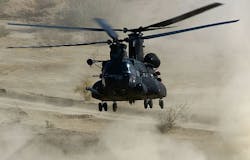Boeing paving the way for building upgraded versions of Special Operations MH-47G helicopter
Officials of U.S. Special Operations Command at McDill Air Force Base, Fla., announced a $27 million contract earlier this month to the Boeing Defense, Space & Security segment in Philadelphia to prepare for manufacturing MH-47G Block 2 helicopters.
Boeing engineers will carry out the Block 2 MH-47G renew project by using new, salvaged, reworked, or recapitalized components into an upgraded airframe, Special Operations Command officials say.
This upgrade to the Special Operations MH-47G includes new composite rotor blades, an improved drive train, single sponson fuel tanks, and strengthened aft, pylon, and nose sections.
Related: Army awards $208.5 million contract to UTC Aerospace for helicopter laser threat warning
The MH-47G heavy-lift helicopter is similar to the MH-47E, but has more sophisticated avionics including a digital common avionics architecture system (CAAS) -- a common glass cockpit used by different helicopters. The Block 2 upgrade are expected to enable the Special Forces MH-47G to operate into the 2060s.
The MH-47G is an advanced heavy-lift helicopter that is operated by the 160th Special Operations Aviation Regiment (SOAR) at Fort Campbell, Ky.
The MH-47G is the most current and sophisticated MH-47 in service. It uses two T55-GA-714A engines with infrared exhaust suppressors to reduce the helicopter's vulnerability to infrared sensors and infrared-guided missiles.
Large fuel tanks that extend from the sides of the helicopter extend the MH-47G's range, and the aircraft has an extendable probe for mid-air refueling.
Related: Raytheon continues building terrain-following radar to infiltrate enemy territory
The MH-47G has a glass digital cockpit that is compatible with night-vision goggles. It has five 6-by-8-inch liquid crystal multi-function display screens and two control display units. The cockpit shares the same processing and display units as the MH-60M Black Hawk helicopter.
The cockpit also has digital moving map display, dual MIL-STD-1553 digital databuses, AN/ASN-137 inertial Doppler navigational set, CP1516-ASQ automatic target hand-off system, AN/ASN-149(V)2 GPS receiver, and Rockwell Collins AN/ARN-149(V) low-frequency automatic direction finder.
A foward-looking infrared (FLIR) and visible-light camera are mounted in a bubble under the helicopter's chin to enable pilots to fly low level, at night, and in bad weather. The CH-47G also has the Raytheon Silent Knight multi-mode radar that enables terrain-following, terrain-avoidance, and weather detection.
For more information contact Boeing Defense, Space & Security online at www.boeing.com/defense, or U.S. Special Operations Command at www.socom.mil.
Learn more: search the Aerospace & Defense Buyer's Guide for companies, new products, press releases, and videos
